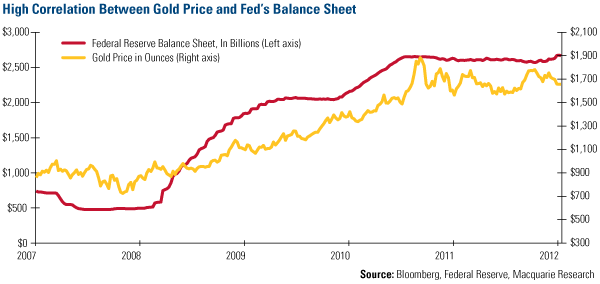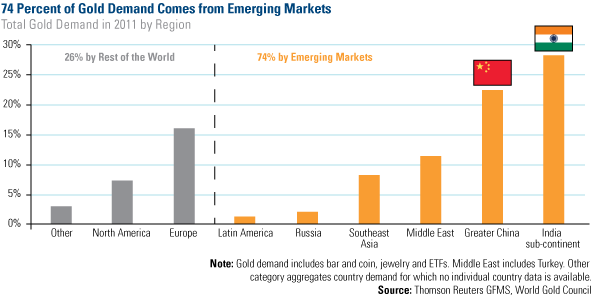When investing in gold, I often say diverse opinions promote critical thinking and a healthy market. I believe elevated groups of buyers and sellers create a competitive tug-of-war in the bid-and-ask-price of the precious metal.
Last week we saw gold bears growling louder and gaining strength, as the world’s largest gold-backed ETF -- the SPDR Gold Trust -- experienced its largest one-day outflows since August 2011. The fear trade fled the sector following the Federal Reserve’s meeting that revealed a growing dissension among some of its members over the central bank’s bond-buying program.
Despite the discord, the Fed is continuing its course to purchase $85 billion of bonds every month and keep interest rates near zero. Ben Bernanke’s plan bloating the balance sheet to more than $3 trillion has been keeping the Fear Trade coming back for more metal.
For good reason, too, as the correlation between the Fed’s balance sheet and the price of gold has historically been very high, at 0.93, according to Macquarie Research. The firm found that for every $300 billion expansion in the balance sheet of the U.S. government, there was a $100 an ounce increase in the price of gold. When you factor in the Fed’s current bond purchases totaling $85 billion per month for the next nine months, the central bank will be adding $765 billion in new assets. “Using the previous ratio, this would compute to a $255 an ounce increase in the gold price,” says Macquarie. By this measure alone, gold would rise approximately 16 percent over the next several months.
On Bloomberg’s Taking Stock with Pimm Fox on February 22, I said that Bernanke will likely keep liquidity high for quite some time, in his effort to meet his goal of lowering the unemployment rate. If the Fed did take its foot off the bond-buying pedal sooner than planned, such a move is apt to shake the resolve of some gold buyers. It’s easy to be confident in gold in times of extreme fear; when the economy improves, one may no longer feel that gold stands on solid ground.
Take another period characterized by extreme volatility and fear, when there was conflict in the Middle East, oil-related inflation shocks, declining value in the U.S. dollar, rising U.S. unemployment and a strong resolve from the Fed to act aggressively. This was four decades ago, after President Richard Nixon removed the gold standard, and the yellow metal climbed to a peak of $850 by January 1980.
Back then, India and China had little financial footing in global markets; gold demand from these areas of the world was about 15 percent of total demand.
Since then, we’ve seen a rapid increase in GDP and incomes, resulting in a dramatic rise in gold demand. According to the World Gold Council (WGC), there’s now an “increasing relevance of emerging markets in the gold market, particularly over the past 12 years.” In 2011, you can see that emerging markets accounted for 74 percent of total bar and coin, jewelry and ETFs gold demand. India and China alone make up 50 percent, and together with Turkey, Vietnam, and Southeast Asia, these countries’ residents clearly “have a cultural affinity to gold,” says the WGC.
To help investors analyze whether gold continues to be a wise investment, I like to refer to the book The Wisdom of Crowdsby James Surowiecki. There are four factors to consider whether a crowd is suffering from groupthink or is making wise decisions:
- Is there a diversity of opinion?
- Are investors independently acting on their best interests?
- Is there a decentralization of gold believers?
- Is there aggregation?
Read Evaluating the Wisdom of Buying Gold to see a summary of each factor for your reference. I believe you’ll find these factors continue to be valid for gold.
Ultimately, the key to gold is moderation. As I said in my book, The Goldwatcher, and often reiterate to investors when I speak at conferences, gold is a volatile asset class and the daily price can be more dramatic than blue-chip stocks. We have always advocated that investors hold a modest 5 to 10 percent weighting in gold and gold stocks. In other words, we feel strongly that an investor should not try to get rich from the metal.
Marc Faber expressed a similar idea in this month’s Gloom Boom and Doom Market Commentary. Instead of selling his gold when the price is falling and buying it back at a lower price, he says he doesn’t stray from his asset allocation approach. He holds a 25 percent allocation to gold, which is much higher than we recommend, and believes that if the price of gold declined, it is likely that his financial assets would increase.
In his closing, Faber reminds readers of the English Proverb: “When we have gold, we are in fear; When we have none, we are in danger.” If the proverb were written today, it might be revised to say, “When we have gold, we are in love.”
U.S. Global Investors, Inc. is an investment management firm specializing in gold, natural resources, emerging markets and global infrastructure opportunities around the world. The company, headquartered in San Antonio, Texas, manages 13 no-load mutual funds in the U.S. Global Investors fund family, as well as funds for international clients.
All opinions expressed and data provided are subject to change without notice. Some of these opinions may not be appropriate to every investor. The following security mentioned was held by one or more of U.S. Global Investors Funds as of 12/31/12: SPDR Gold Trust ETF.
